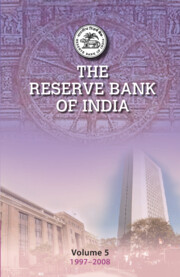Book contents
- Frontmatter
- Contents
- Tables
- Boxes
- Foreword
- Preface
- Acknowledgements
- List of Abbreviations
- 1 Introduction: Managing Liberalisation
- 2 The Macroeconomic Context
- 3 Monetary Management
- 4 Foreign Exchange Market and Management of the Capital Account
- 5 Foreign Exchange Reserves Management
- 6 Financial Markets
- 7 Public Debt Management
- 8 The Payment and Settlement Systems
- 9 Currency Management
- 10 Regulation of the Financial System – Part I: Commercial Banks
- 10 Regulation of the Financial System Part II: Other Financial Institutions
- 11 Supervision of the Financial System
- 12 Rural Credit
- 13 Financial Inclusion
- 14 Communication Policy
- 15 Organisational Change
- Appendices
- Photographs
- Select Bibliography
- Index
14 - Communication Policy
Published online by Cambridge University Press: 10 January 2023
- Frontmatter
- Contents
- Tables
- Boxes
- Foreword
- Preface
- Acknowledgements
- List of Abbreviations
- 1 Introduction: Managing Liberalisation
- 2 The Macroeconomic Context
- 3 Monetary Management
- 4 Foreign Exchange Market and Management of the Capital Account
- 5 Foreign Exchange Reserves Management
- 6 Financial Markets
- 7 Public Debt Management
- 8 The Payment and Settlement Systems
- 9 Currency Management
- 10 Regulation of the Financial System – Part I: Commercial Banks
- 10 Regulation of the Financial System Part II: Other Financial Institutions
- 11 Supervision of the Financial System
- 12 Rural Credit
- 13 Financial Inclusion
- 14 Communication Policy
- 15 Organisational Change
- Appendices
- Photographs
- Select Bibliography
- Index
Summary
Introduction
In keeping with international trends, the Reserve Bank made significant changes to make its communication policy more transparent during the reference period. Global trends, together with domestic factors, such as liberalisation, increasing reliance on market-based instruments and the opening of financial markets, led the Bank to disseminate more information to stakeholders and to the public and at the same time avoid disrupting financial markets. While maintaining transparency, quality and timeliness, the Bank sought to achieve clarity on its own roles and responsibilities, manage expectations, promote two-way flow of information, collect statistics and conduct research.
Over the years, the communication strategy was strengthened. At the beginning of the reference period, existing communication channels consisted of periodic publications of monthly monetary and credit information reviews, Reserve Bank of India (RBI) Monthly Bulletins, Annual Reports, speeches of senior executives, circulars and notifications, data series, pamphlets and other reports to make information available to bankers, academics and general public. The launch of its own website in 1996 marked the beginning of electronic dissemination of information. Internally, the Governor’s New Year Letters, RBI newsletters, in-house magazines, monthly demi-official letters to the Governor by Regional Directors, internal manuals, and conferences of Regional Directors served well to disseminate information and communicate to the staff.
During the reference period, the communication policy became more transparent, interactive and receptive to feedback (also see Box 14.1). The communication process engaged market participants. Draft reports, circulars and notifications were placed on the website, and comments on these were invited from the public before the reports became final. The Technical Advisory Committee for Monetary Policy (TACMP) created a platform for greater interaction with the outsiders in the process of monetary policy formulation. At the same time, data dissemination improved, partly by adhering to the International Monetary Fund (IMF) standards. Increased interactions with media followed the announcement of the monetary policy. The Bank responded to media reports more than before. The speeches of the executives became more comprehensive and transparent in content and reach.
The Bank’s communication policy had two components, external and internal. External communication was conducted by means of press releases, speeches, publications, notifications, circulars, frequently asked questions (FAQs), advertisements, media interviews and the website, and focused on areas such as the macroeconomic situation, monetary and fiscal policies, banking, financial markets, payment systems and external sector developments.
- Type
- Chapter
- Information
- The Reserve Bank of IndiaVolume 5, 1997–2008, pp. 596 - 613Publisher: Cambridge University PressPrint publication year: 2023



